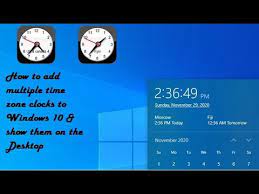Mastering Time Management: A Comprehensive Guide to Adding Clocks from Multiple Time Zones in Windows 10

In today’s interconnected world, the ability to manage time across different time zones is essential for global communication, collaboration, and productivity. Whether you’re a business professional coordinating meetings with international clients, a traveler planning itineraries across different continents, or simply someone with friends and family living in different parts of the world, having access to clocks from multiple time zones can streamline your scheduling and ensure timely interactions. Fortunately, Windows 10 offers a built-in feature that allows users to add clocks from multiple time zones directly to the taskbar, providing quick and easy access to global time information. In this extensive guide, we will explore the step-by-step process, tips, and best practices for adding clocks from multiple time zones in Windows 10, empowering you to effectively manage time across borders and time zones.
Understanding the Importance of Multiple Time Zone Clocks:
Managing time across multiple time zones presents unique challenges and considerations, including scheduling conflicts, time zone conversions, and coordination across geographical boundaries. By adding clocks from multiple time zones in Windows 10, users can effortlessly track time differences, plan meetings or events, and stay synchronized with colleagues, friends, and family members around the world. Whether you’re a frequent traveler, a remote worker, or a global business professional, having access to multiple time zone clocks ensures that you can stay connected and productive regardless of your location or time zone.
Adding Clocks from Multiple Time Zones in Windows 10:
Now, let’s explore the step-by-step process for adding clocks from multiple time zones to the taskbar in Windows 10:
- Open Date and Time Settings: Click on the clock in the taskbar to open the date and time display. Alternatively, right-click on the clock and select “Adjust date/time” from the context menu.
- Go to Additional Clocks: In the Date & time settings window, navigate to the “Additional date, time, & regional settings” section and click on “Add clocks for different time zones.”
- Add Additional Clocks: In the Date and Time window, select the “Additional Clocks” tab. Check the box next to “Show this clock,” then choose the desired time zone from the dropdown menu. You can add up to two additional clocks in addition to your local time.
- Customize Clock Names: Next to each additional clock, enter a descriptive name to identify the time zone, such as “New York” or “Tokyo.”
- Save Changes: Click “Apply” and then “OK” to save your changes and close the Date and Time window.
- View Additional Clocks: Now, when you click on the clock in the taskbar, you’ll see the current time for your local time zone as well as the additional clocks you’ve added. Hovering over the clock will display the full date and time for each time zone.
Tips and Best Practices:
To make the most of multiple time zone clocks in Windows 10, consider the following tips and best practices:
- Customize Clock Order: Arrange the additional clocks in the order that makes the most sense for your needs. For example, you may want to prioritize clocks for frequently visited locations or key business partners.
- Account for Daylight Saving Time: Keep in mind that some regions observe daylight saving time, which may affect the time difference between time zones. Be sure to adjust the clocks accordingly when daylight saving time begins or ends.
- Use Alarms and Reminders: Take advantage of Windows 10’s built-in alarms and reminders to stay on schedule and avoid missing important appointments or meetings across different time zones.
- Consider Widget or App Alternatives: While Windows 10’s built-in multiple time zone clocks are convenient, you may also explore third-party widgets or apps that offer additional features or customization options for managing time across multiple time zones.
Conclusion:
In conclusion, adding clocks from multiple time zones in Windows 10 is a valuable feature that empowers users to effectively manage time across borders and time zones. Whether you’re a global business professional, a frequent traveler, or simply someone with connections around the world, having access to multiple time zone clocks ensures that you can stay connected, organized, and productive regardless of your geographical location. By following the step-by-step instructions, tips, and best practices outlined in this guide, you can seamlessly integrate multiple time zone clocks into your Windows 10 experience and master the art of global time management. So, take advantage of this powerful feature, stay synchronized with colleagues and loved ones worldwide, and make the most of your time in the digital age.




